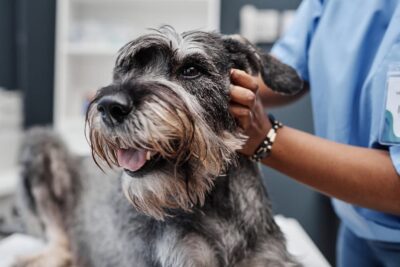Vestibular Disease in Dogs

Overview
- Vestibular disease is often characterized by dizziness and spinning sensations.
- There can be a variety of causes including ear infections, ear trauma, tumors, and toxins.
- Vestibular disease is divided into two categories—central and peripheral.
- Some cases can be cured with medication and supportive care.
If you’ve ever suffered from vertigo or inner ear problems, you already have some idea of what it feels like to have vestibular disease.
Vestibular disease in dogs is often characterized by the same dizziness and spinning sensations that humans experience. This causes dogs to feel nauseous and off-balance.
While it can be scary seeing your dog circling and stumbling, the good news is that many cases of vestibular disease can be cured with medications and supportive care.
What Is Vestibular Disease?
The vestibular system in dogs is a complex array of structures involving the inner ear, cranial nerves, and the brain. This system is responsible for maintaining balance, posture, and equilibrium. When the vestibular system is compromised by illness or injury, your dog may experience dizziness, loss of balance, and motion sickness symptoms.
Vestibular disease is divided into two categories based on which part of the vestibular system is affected. In central vestibular disease, the problem is localized to the brain. In peripheral vestibular disease, structures outside the brain such as the inner ear or cranial nerves are affected. Cranial nerves are a set of 12 major nerves that start in the brain and primarily send nerve signals to structures in the head and neck.
Determining which type of vestibular disease your dog has in an important step to help guide treatment.
What Causes Vestibular Disease in Dogs?

There are many different causes of vestibular disease in dogs. In some cases, identifying and treating the underlying cause of the vestibular disease can cure the condition. In others, an exact cause for the symptoms may never be identified.
Peripheral vestibular disease is most commonly caused by infection or trauma to the ear. Infections affecting the external ear—known as otitis externa—may extend to the middle or inner ear and cause vestibular signs, especially if the eardrum is damaged.
Other causes of peripheral vestibular disease include:
- Certain toxins
- Congenital disorders
- Tumors that affect the cranial nerves
Central vestibular disease is caused by a problem in the brain, such as a tumor or infection. This type of vestibular disease is often more serious and more difficult to treat.
Other causes of central vestibular disease include:
- Granulomatous meningoencephalitis
- Hypothyroidism
- Certain toxins
The most common type of vestibular disease is idiopathic vestibular disease. Idiopathic means that an exact cause for the disease cannot be identified. It is also commonly referred to as “old dog vestibular disease” because it primarily occurs in senior dogs. This type of vestibular disease typically resolves on its own with time and supportive care.
Symptoms of Canine Vestibular Disease

Symptoms of vestibular disease in dogs are often sudden and dramatic. Dogs with vestibular disease may lose their balance, appear disoriented, or struggle to walk—often causing pet owners to worry that their dog has had a stroke.
Symptoms of vestibular disease may worsen over time or in some cases may begin to improve.
Other signs of vestibular disease in dogs include:
- Head tilt
- Circling
- Stumbling, falling, or rolling to one side
- Nystagmus, or abnormal movement of the eyes
- Weakness
- Tremors
- Abnormal gait
- Nausea and vomiting
- Loss of appetite
- Lethargy
Diagnosing Vestibular Disease

If your dog shows signs of vestibular disease, it is important to seek veterinary care right away. Other conditions can present with similar symptoms, so your veterinarian will perform a full physical examination and may recommend diagnostic tests to help identify the cause of your pet’s signs.
Tests used to diagnose vestibular disease include:
Bloodwork
Bloodwork (CBC/chemistry profile/thyroid) can help rule out any metabolic or inflammatory causes of clinical signs. It may also be useful for pre-anesthetic testing, in the event that anesthesia is needed for more extensive diagnostics.
Ear Examination
An examination of your pet’s ears may be recommended to help identify peripheral vestibular disease caused by an ear infection. In some cases, your veterinarian may recommend sedating your pet for the examination. This will keep your pet comfortable while the ear canal is thoroughly examined and flushed. Your veterinarian may also recommend taking samples from your pet’s ear canal to identify the type of bacteria causing the infection, which will help guide appropriate treatment for your pet.
Neurologic Examination
Your veterinarian may perform a neurological exam on your dog. This includes evaluating your dog’s reflexes, posture, and gait. This type of examination can help your veterinarian determine whether the vestibular disease is peripheral or central, and can identify which parts of the vestibular system are affected.
Diagnostic Imaging
Your veterinarian may recommend X-rays, MRI, or CT scans to visualize your pet’s brain and inner ear structures. This is especially important in cases of central vestibular disease. For advanced imaging such as MRI or CT, your pet will need to be placed under general anesthesia for the procedure.
How to Treat Vestibular Disease in Dogs

The treatment options for vestibular disease vary depending on the underlying cause of the illness. Some cases can be cured with appropriate medication and supportive care. Others, such as those caused by tumors in the brain or cranial nerves, often have limited treatment options and a poorer prognosis. Treatment for central vestibular disease can depend on the cause, but can range from steroids, antibiotics, chemotherapy, and radiation.
Medications for Vestibular Disease in Dogs
Antibiotics. If your dog’s vestibular disease is caused by an infection, your veterinarian will likely prescribe antibiotics to treat the condition. An inner ear infection may be treated with topical or oral antibiotics or both. Remember to always complete the full course of any antibiotic medication, even once your pet’s signs begin to improve. Treatment for causes such as infection of the ear canal may take four to six weeks of antibiotics to resolve.
Sedatives. Sedatives may be prescribed for severe disorientation.
Intravenous fluid therapy. Intravenous fluid therapy may be prescribed to patients who cannot drink or are dehydrated.
Anti-emetics. Vestibular disease can make your dog feel dizzy and nauseous. Oral anti-emetic medications such as dimenhydrinate (Dramamine) or maropitant citrate (Cerenia) may be prescribed to keep your pet comfortable. These medications can also help with the loss of appetite that occurs as a result of vestibular disease.
Cost to Treat Canine Vestibular Disease
The cost to treat vestibular disease in dogs largely depends on the underlying cause of the disease.
Idiopathic or Old Dog Vestibular Disease typically resolves within a few weeks with supportive care alone. Cases of peripheral vestibular disease caused by ear infections can also often be cured with antibiotic therapy and supportive care.
Pet owners can expect to spend about $100-$500 on treatment in these cases, depending on the severity of the disease.
Other causes of vestibular disease, such as tumors, encephalitis, or toxins may be much more expensive to treat and may have a poorer prognosis.
How to Prevent Vestibular Disease
Most cases of vestibular disease cannot be prevented. However, in dogs prone to ear infections, peripheral vestibular disease can be prevented by checking the ears frequently and seeking veterinary care at the first sign of infection.
It is especially important to ensure your dog’s ears are dried thoroughly after bathing or swimming to reduce the risk of infection. Your veterinarian may also recommend a maintenance ear cleaner for your dog to keep the ears dry and reduce the growth of bacteria and yeast.
Related Conditions
- Otitis externa
- Granulomatous meningoencephalitis
- Canine distemper
- Hypothyroidism
- Horner’s Syndrome









